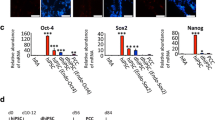Abstract
Bradycardia causes slow heart beating, which has high risk for heart failure or stroke. The only available treatment for bradycardia is implantation of electronic pacemakers. However, this treatment for bradycardia has several shortcomings: requirement of operation for implantation and for exchange of battery and the lack of response to autonomic nerve regulation. The purpose of this study was to develop a biological pacemaker, which could be used for replacement of electronic pacemakers.
You have full access to this open access chapter, Download chapter PDF
Similar content being viewed by others
Keywords
Bradycardia causes slow heart beating, which has high risk for heart failure or stroke. The only available treatment for bradycardia is implantation of electronic pacemakers. However, this treatment for bradycardia has several shortcomings: requirement of operation for implantation and for exchange of battery and the lack of response to autonomic nerve regulation. The purpose of this study was to develop a biological pacemaker, which could be used for replacement of electronic pacemakers.
-
1.
In differentiating mouse embryonic stem (mES) cells, cardiac pacemaker cells can be specifically visualized with green fluorescent protein (GFP) on the basis of their specific expression of hyperpolarization-activated cyclic nucleotide-gated (HCN) channel 4 at sinoatrial node (SAN) [1]. GFP knock-in ES cells at HCN4 locus (H7 clone) were established. The expression of GFP was specifically restricted at their contracting region in differentiating H7 ES cells.
-
2.
Cell sorting revealed that a few cells (0.1–0.5 %) of H7 embryoid bodies (EBs) were GFP positive, of which approximately 80 % of cells showed the spontaneous beating activity with cesium-sensitive action potential. Sorted GFP+ cells expressed endogenous HCN4 and had essentially the same properties as the cardiac pacemaker cells at SAN.
-
(i)
GFP+ cells expressed cardiac pacemaker specific markers such as HCN4, Cav3.1, and Connexin43 as well as cardiomyocyte-specific marker, Tropomyosin C.
-
(ii)
Patch-clamp analysis revealed that GFP+ cells expressed pacemaker current If with spontaneously oscillating action potentials (automaticity) (Fig. 41.1).
-
(iii)
GFP+ cells were capable of actively responding to adrenergic stimulation and cholinergic repression.
-
(i)
-
3.
We further investigated whether mESC-derived HCN4+ cells can restore myocardial electromechanical properties. Using imaging techniques, we demonstrated that HCN4+ cells established electrical coupling with HL-1 cells, a cardiac muscle cell line derived from the mouse atrial cardiomyocytes tumor, to induce rhythmic electrical and contractile activities in vitro. Similarly, transplanted HCN4+ cells paced the hearts of rats with complete atrioventricular block, indicating that HCN4+ cells could substitute for pacemaker cells and elicit an ectopic rhythm.
These results demonstrated the potential of HCN4+ pacemaking cells derived from ES cells to act as a rate-responsive biological pacemaker and for future myocardial regenerative medicine to bradycardia.
Reference
Morikawa K, Bahrudin U, Miake J, et al. Identification, isolation and characterization of HCN4-positive pacemaking cells derived from murine embryonic stem cells during cardiac differentiation. PACE. 2010;33:290–303.
Author information
Authors and Affiliations
Corresponding author
Editor information
Editors and Affiliations
Rights and permissions
Open Access This chapter is distributed under the terms of the Creative Commons Attribution-Noncommercial 2.5 License (http://creativecommons.org/licenses/by-nc/2.5/), which permits any noncommercial use, distribution, and reproduction in any medium, provided the original author(s) and source are credited. The images or other third party material in this chapter are included in the work's Creative Commons license, unless indicated otherwise in the credit line; if such material is not included in the work's Creative Commons license and the respective action is not permitted by statutory regulation, users will need to obtain permission from the license holder to duplicate, adapt or reproduce the material.
Copyright information
© 2016 The Author(s)
About this chapter
Cite this chapter
Morikawa, K., Shirayoshi, Y., Hisatome, I. (2016). Specific Isolation of HCN4-Positive Cardiac Pacemaking Cells Derived from Embryonic Stem Cells. In: Nakanishi, T., Markwald, R., Baldwin, H., Keller, B., Srivastava, D., Yamagishi, H. (eds) Etiology and Morphogenesis of Congenital Heart Disease. Springer, Tokyo. https://doi.org/10.1007/978-4-431-54628-3_41
Download citation
DOI: https://doi.org/10.1007/978-4-431-54628-3_41
Published:
Publisher Name: Springer, Tokyo
Print ISBN: 978-4-431-54627-6
Online ISBN: 978-4-431-54628-3
eBook Packages: MedicineMedicine (R0)





